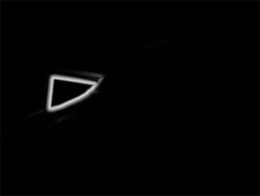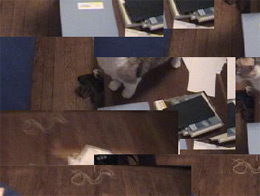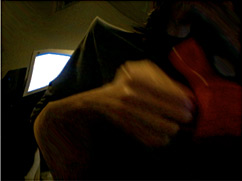Information, Meaning and Interaction in Digital Media
Carlos Castellanos
MAT 256, Winter 2005: Professors Jerry Gibson & George Legrady
|
The following summarizes my research and production work conducted while in Professors Jerry Gibson and George Legrady's MAT course "Visual Design Through Algorithms". The professors were interested in issues such as video quality to determine human perceptual models and the aesthetic and technical issues in the production of an interactive visual environment. This correlates nicely with my interests, namely the relationship between information and meaning and interaction, interfaces and communication in digital media (these are discussed below in more detail). To that end, we collectively as a class decided to learn and use the Max/MSP/Jitter software package (Jitter in particular as it designed for real-time video processing) to realize a group project. The follwing details some of my experiments and contributions to that project. Introduction How are information and meaning related? The answer to this question varies depending on who you ask. Artists and critical theorists may refer to the cultural "information" (i.e. meaning, or lack of meaning) in a given painting phototgraph or other image. However, an engineer, refering to Claude Shannon's Information Theory (which gives a specific narrow definition of information) would say that there is no information there, as there is nothing new being generated. In fact to an engineer, full spectrum white noise (like the "snow" on television) contains the most amount of noise possible. So this leaves me with the question: Does adding or removing information (however you define it) from an image through resampling, compressing noise, blurring, etc, alter its meaning? This question forms the basis of my investigations. Exploring the relationship between information and meaning Starting with the idea of adding and removing information from real-time video signals (i.e. noise, resampling and otherwise |
|
"deconstructing" or "reconstructing" the video image) and using motion tracking/sensing to accomplish this, I began to explore the relationship between information and meaning. With digital data there is - in a sense - "no there there". With it's quality of being infinitely alterable, digital data is by nature subjective, arbitrary and ephemeral. Interaction With a mouse or any other control device, all the system knows about you is what it attains through that device and whatever you as a user do with it. I have always been interested in exploring better modes of interaction and communication both between humans and technology and between humans themselves, mediated by technology. The way we interface with our technology shapes the way the content provided by the technology is experienced and perceived. Interface and content are inextricably linked. In short, interface = content. Interfaces can distort our perceptions but can also, if the systems are well-designed, promote or enhance new modes of communication. This is why for our group project I proposed an interactive installation to explore these issues. My idea was an installation that would consist of two spaces, each containing a dark, fuzzy or otherwise indiscernible image, which is in fact a live video feed from the other person's space. If their images happen to intersect, a "portal" opens up and each participant can see the other, allowing for interaction and communication via motion and gesture (which is required to keep the portal open). The portal then becomes the interface. It is the boundary zone of interaction and communication and it shapes how one interacts and how one experiences the piece. Interface = content. More details on this project are available at the MAT 256 course website. Production and Experiments in Jitter A. Motion tracking and resampling One of my first experiments was to using motion tracking to affect the amount of resampling in an image. Basically depending on where one stood |
|
through my studies in MAT. References
Jitter |



